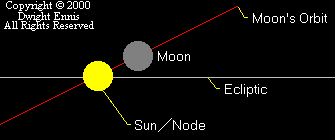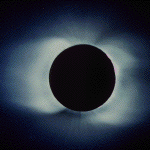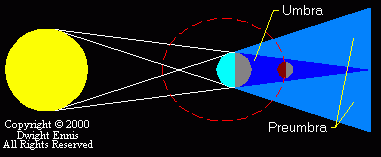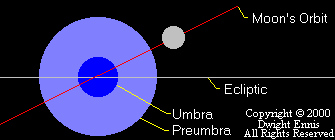Eclipses And The Moon’s Nodes
Few astronomical phenomenon are as impressive as an eclipse. Whether it be a total eclipse of the Sun, with the turning of day into night, and the filmy, iridescent corona surrounding a black disk where, moments before, the fiery brightness was blinding, or a total eclipse of the Moon, when its usually silvery disk turns blood-red, eclipses have awed man since history began. Historically, they have been said to be harbingers of catastrophe, and astrologers have always placed great meaning upon them. Part of the reason for this is that they always happen in proximity to one of the Moon’s Nodes – either North or South – bringing an additional energy into an otherwise normal New Moon. Additionally, the declinations of the Sun and Moon are always the same, or nearly so, during an eclipse, adding a Parallel Aspect between the two, and throwing further “fuel on the fire.” There are, naturally enough, astronomical principles at work behind these events. Explaining these principles is the purpose of this article.
First, you need to be familiar with four terms – the (geometric) plane, the ecliptic, celestial latitude, and declination.
- The Plane: The dictionary defines a plane as: “any flat or level surface”, and also as a “surface such that if any two points on it are joined by a straight line, the line will be contained wholly in the surface”1. Simply put, a plane is a two-dimensional surface. A circle (or an ellipse), describes a plane – if viewed from the side, it will appear as a line.
- The Ecliptic: The path of the Earth’s orbit around the Sun is called the ecliptic. This path is an ellipse (as are all orbital paths of one heavenly body around another), and as such, describes a plane, the plane of the ecliptic.
- Celestial Latitude: The angular distance of a star or planet above or below the ecliptic is the celestial latitude of that star or planet.
- Declination: The angular distance of a star or planet above or below the Celestial Equator (NOT the ecliptic), is the declination of that star or planet.
A more detailed discussion of these terms may be found in one of my previous articles. You’ll understand the following a lot better if you already understand the information presented there.
The Moon’s Nodes and the Nodal Axis
Just as the path of the Earth’s orbit around the Sun (the ecliptic), describes a plane, so too does the orbit of the Moon around the Earth describe another plane. The orbit of the Moon is extremely complex because of the combined influences of the Sun, the Earth, and the Moon, and their intricate gravitational interactions, but such is beyond the scope of this article, and unnecessary in understanding eclipses, so let’s keep it simple.
The plane of the Moon’s orbit is inclined with respect to the ecliptic. This angle varies due to the complexity of the Moon’s orbit, but the average inclination is 5° 08′. The intersection of these two orbital planes form an axis, or line, and the points of intersection are called the Moon’s Nodes. This is graphically illustrated in Figure 1.
A second illustration can aid in further clarifying things. In Figure 2, I’ve shown the orbital planes as solid disks instead of circles, and I’ve shown the line of the Nodal Axis.
Due to the inclination of the Moon’s orbit with respect to the ecliptic, the Moon spends half its time in North Celestial Latitude, and the other half in South Celestial Latitude. The point where the Moon crosses the ecliptic moving from South to North Celestial Latitude is the North Node, while the point where it crosses moving from North back to South Celestial Latitude is the South Node.
As the Earth traverses its yearly path around the Sun, the Nodal Axis travels along with it. There are two times during the course of the year, approximately six months apart, where the Nodal Axis is aligned with, or pointing at, the Sun, as shown in Figure 3.
I say approximately six months apart because (a) our calendar doesn’t precisely correspond to the Earth’s annual orbit, and (b) because of an additional movement of the Nodes.
The Retrograde Motion of the Nodes
As previously mentioned, the combined gravitational interactions of the Sun, Earth, and Moon creates great complexity in the Moon’s orbit of the Earth (actually, the Moon doesn’t really orbit the Earth – they orbit each other around a common center of gravity roughly 3000 miles from the Earth’s center). One of the motions introduced by this interaction is a wobble in the Moon’s orbit, similar to the wobble of a top. This wobble causes the Nodes to regress (move backwards), retrograding through the Zodiac, and describing one complete circle every 6793.4 days, or about every 18.6 years. In Figure 4, I’ve shown this retrograde motion of the Nodes. In each frame of the animation, the Earth’s position relative to the Sun is the same, as is the Moon’s position relative to the Earth and Sun – the Moon is in Opposition to the Sun, or at Full Moon. The time-frame of Figure 4 is one Nodal revolution, or about 18.6 years.
I previously said that the Nodes will align with the Sun twice a year at approximately six month intervals. From Figure 4, you can see that it isn’t only the Earth moving around the Sun that brings the Nodes into alignment – it’s also the retrograde motion of the Nodes themselves. In the half-year it takes the Earth to traverse half its orbit of the Sun, the Nodes themselves have also moved. The Earth takes 365.25 days to complete one revolution, or 360°, so half that would be 182.625 days. The Nodes take 6793.4 days to complete one revolution, so in the 182.625 days that correspond to half the Earth’s orbital period, the Nodes have regressed…
182.625 days divided by 6793.4 days = 0.0269 times 360° = 9.678°.
9.678° divided by 180° = 0.0538 times 182.625 days = 9.82 days.
So the alignment interval would be about 172.8 days (182.625 – 9.82).
The Moon’s Varying Celestial Latitude
All this stuff about the Nodes is fine, you say, but what does it have to do with eclipses? I’m coming to that. Figure 4 can be looked at another way. Instead of depicting Nodal Regression, let’s assume that it depicts 24 successive Full Moons, with 29.53 days between each. The time-frame of Figure 4 is then 29.53 days times 24 frames = 708.72 days. We are moving along with the Earth, maintaining the exact same relative position and viewpoint throughout.Viewed in this way, we can see that the Celestial Latitude of the Full Moon depends upon its position relative to the Nodal Axis. If the Full Moon takes place exactly conjunct one of the Nodes, its Celestial Latitude is 0°. If the Full Moon happens when its 90° from the Nodal Axis, it will be at about 5° 08′ North or South Celestial Latitude. A Full Moon anywhere in between will find the Celestial Latitude somewhere in between. The same holds true for a New Moon conjunct one of the Nodes, or any other lunar phase. Keep this in mind, because we’ll return to it in explaining eclipses.
Perigee and Apogee, and Perihelion and Aphelion
We need to cover a few more related things before tackling eclipses. First, the orbit of the Moon is not a circle, but rather an ellipse. So is the orbit of the Earth. So is the orbit of every celestial body we know of. An ellipse doesn’t have a center as a circle does. Instead, it has two foci (plural of focus). The more elongated (oval-shaped), the ellipse, the more distance between the foci. In the case of one body elliptically orbiting another, the orbited body (or, as is the case with the Earth and Moon, the common center of gravity), is positioned at one focus. The result is that the distance between the orbited body (say the Sun), and the orbiting body (say the Earth), varies, as does the speed of the orbiting body (in this case, the Earth). To use that example, when the Earth is closest to the Sun, it is said to be at perihelion(2), and when it’s furthest away, it’s said to be at aphelion. As the Earth approaches perihelion, the Sun’s gravity pulls in the direction of its motion, causing its speed to increase. As the Earth swings past perihelion and begins moving away from the Sun towards aphelion, the Sun’s gravity pulls in the opposite direction of its motion, causing it to slow down. These principles also apply to the Moon, Venus, Jupiter – in fact, to all orbiting bodies.
Different yet similar terms are used for the Moon – when the Moon is closest to Earth, it’s said to be at perigee, and when furthest away, at apogee.
The relative distances are as follows:
- Earth at perihelion 91.34 million miles from the Sun
- Earth at aphelion 94.51 million miles from the Sun
- Moon at perigee 225 thousand miles from the Earth
- Moon at apogee 252 thousand miles from the Earth
Why is this important?
The Visible Size of the Sun and the Moon
We all know that an object appears bigger when it’s closer to us, and smaller when it’s further away. The same is true of the Sun and Moon. When the Earth is at perihelion, and the Sun is closest to us, the Sun’s apparent semidiameter in the sky is 16.3′ (minutes), of arc. When the Earth is at aphelion, and the Sun is most distant, its apparent semidiameter is only 15.8′ of arc.
Similarly, when the Moon is at perigee, its apparent semi-diameter is 16.8′ of arc, while at apogee, it’s only 14.7′ of arc. This has direct bearing upon eclipses, as we shall see.
The Eclipse
Finally!!! If you’ve gotten this far, you can already see that many things will affect if and how an Eclipse will appear. An Solar Eclipse occurs when the Moon passes between the Sun and the Earth in such a way as to partially or completely obscure our view of the Sun. A Lunar Eclipse occurs when the Moon passes behind the Earth in such a way that it moves through the Earth’s shadow (in other words, when the Earth is between the Sun and the Moon – exactly opposite from the Solar Eclipse). Solar Eclipses therefore happen at the New Moon, and Lunar Eclipses happen at the Full Moon.
For an Eclipse to happen at all, the Sun, Earth, and Moon must be aligned, not only in Celestial Longitude, but also in Celestial Latitude (and therefore, in Declination). However, while this alignment in Celestial Longitude happens every 29.53 days, the alignment in Celestial Latitude can only happen near one of the Nodes, or the Nodal Axis. So, an Eclipse requires that there be either a New Moon (Solar Eclipse), or a Full Moon (Lunar Eclipse), near one of the Nodes. The limits upon Eclipses are called Major and Minor Ecliptic Limits.
- Major Ecliptic Limit: A Lunar Eclipse MAY occur if there is a Full Moon within 11° 38′ (Celestial Longitude), of a Node, and a Solar Eclipse MAY occur if there is a New Moon within 17° 25′ of a Node.
- Minor Ecliptic Limit: A Lunar Eclipse MUST occur if there is a Full Moon within 9° 39′ (Celestial Longitude), of a Node, and a Solar Eclipse MUST occur if there is a New Moon within 15° 23′ of a Node.
- If a New or Full Moon occurs within 5° of a Node, the Eclipse will be Total or Annular.
Additionally:
- For a Lunar Eclipse to occur, the Moon’s Celestial Latitude at Full Moon cannot exceed about 55′, and for that Lunar Eclipse to be Total, Celestial Latitude cannot exceed 26′.
- For a Solar Eclipse to occur, the Moon’s Celestial Latitude cannot exceed 1° 27′, and must be less than 58′ for the Solar Eclipse to be Total or Annular.
These limits can be graphically shown with another illustration. In Figure 6a, the New Moon takes place too far from the Node. The result is that none of the Sun’s disk is obscured, and we have a normal New Moon.
Figure 6b shows what happens when the New Moon takes place closer to the Node. While still not close enough to completely cover the Sun, it nonetheless obscures part of the Sun’s disk as it passes. The result is a partial eclipse.
Figure 6c shows the New Moon taking place right on the Node. The Moon completely covers the Sun’s disk, and we have a total eclipse.
While I’ve presented these illustrations using the Solar Eclipse as an example, the same principles hold generally true for Lunar Eclipses. I’ll illustrate that when we get to the section on Lunar Eclipses.
The Solar Eclipse
Most of the astronomical principles behind the Solar Eclipse have already been explained. Figure 7 illustrates the patterns of light and shadow during a Total Eclipse. Because the Moon is so much smaller than the Sun, a Total Eclipse isn’t visible except in a small area of the Earth’s surface. This causes what’s generally called the “track of totality.” Elsewhere, the Eclipse will be seen as Partial, or not seen at all.
Of the three kinds of Solar Eclipse – Total, Partial, and Annular, only the Annular Eclipse still needs some coverage. In a previous section, I discussed the elliptical orbits of the Earth and Moon, and the varying distances made by each to the parent body. We also saw that the apparent sizes of the Sun and Moon vary accordingly. What happens if the Sun’s apparent size is larger than the Moon’s during an eclipse. Suppose, for example, that the Earth is at perihelion, and the Sun’s apparent semidiameter is 16.3′. Suppose at the same time, the Moon is at apogee with an apparent semidiameter of 14.7′. It’s immediately apparent that the disk of the Moon isn’t big enough to completely obscure the disk of the Sun. When this happens, we have an Annular Eclipse, with a visible ring of the Sun still showing around the outer edge of the Moon. In fact, the name “annular” is from the Latin “anulas,” which means “ring.”
As we can see in Figure 9, the Moon isn’t big enough to completely block out the Sun.
The Lunar Eclipse
A Lunar Eclipse happens during the Full Moon when the Sun, Earth, and Moon are aligned in Celestial Latitude, and the Moon passes through the Earth’s shadow. The Earth casts two cone-shaped shadows into space – the smaller called the Umbra, and the larger called the Preumbra. This is illustrated in Figure 9.
A Total Lunar Eclipse occurs when the entire disk of the Moon lies within the Umbra. For this to happen, we once again see that the Moon’s Celestial Latitude must fall within confined limits, and this requires a Full Moon to happen near a Node (specifically, within 9°). If the Full Moon happens outside this tight band, but still close enough to the Node that either (a) part of the Moon passes through the Umbra, with the rest lying in the Preumbra, or (b) none of the Moon passes through the Umbra, but all or part of it pass through the Preumbra, then we have a Partial Lunar Eclipse. Figures 10a and 10b show the Umbra and Preumbra from the point of view of the Earth, from which they appear as circles. The size of the circle depends upon how close to Earth the cone-shaped shadow is cut – in the case of the Umbra, the nearer to Earth you get, the bigger the circle of the shadow, while the reverse is true for the Preumbra. The illustrations cut the shadows at the distance of the Moon’s orbit.
I haven’t bothered to show a normal Full Moon, but in that case, it takes place far enough from the Node that the Moon misses the Preumbra completely.
Where the Full Moon takes place in terms of perigee and apogee will also affect things. If the Full Moon takes place at perigee, the Moon passes through an area where the Umbra is larger, but the Preumbra is smaller.This decreases the chance that an Eclipse will happen at all, but, if it does, increases the chance of a Total Eclipse. If conditions are right and a Total Eclipse does occur, it will last longer since the Moon will have a greater distance to travel before getting out of the bigger Umbra shadow.
If, on the other hand, the Full Moon takes place near apogee, the Umbra is smaller and the Preumbra is larger, increasing the chance of a Partial Eclipse, but reducing the chance of a Total Eclipse, and reducing it’s length should one occur.
The Saros Cycle
With the Moon’s Nodes regressing one complete revolution once every 18.6 years, it takes about 364.62 days for the Sun to make two successive conjunctions to either Node. For example, if the Sun conjuncts the North Node, it will be about 364.62 days until it conjuncts it again., a time period sometimes referred to as The Eclipse Year. It was discovered by the Chaldeans that after 18 years 11-1/3 days (or 18 years, 10-1/3 days if the interval contained five leap years), the Nodes have prescribed 19 revolutions relative to the Sun/Nodal conjunctions (or 19 Eclipse Years), at which time, the Sun and Moon will have returned to almost exactly the same positions relative to the Nodes. This cycle was christened the Saros, and contains an average of 70 Eclipses.
Conclusion
Eclipses are somewhat rare occurrences simply due to the large number of factors that have to be just right in order for them to take place. While the astrological meaning of Eclipses is not the focus of this article, you can gain insight by remembering the additional factors beyond the normal New and Full Moon that go into their manifestation. In addition to the normal New or Full Moon, you also have…
- it occurring conjunct (or, at least, close to) a Node
- a close conjunction in Declination (a Parallel aspect).
Additionally, think about what’s happening during an Eclipse. With the Solar Eclipse, the emotions (Moon), temporarily block, obscure, or get in the way of the light of the Conscious Ego (Sun). In the case of the Lunar Eclipse, the material concerns or the body (Earth), temporarily block the normal flow between the Conscious Ego (Sun), and the emotions (Moon).
……………………………………………………………………..
Notes:
Much of the information in this article came from The Astrologers Astronomical Handbook by Jeff Mayo 1965
1 – Comprehensive Desk Dictionary – Thorndike : Barnhart
2 – An interesting aside is that Earth is at perihelion, or as close to the Sun as it gets, near the Winter Solstice – about two weeks after it.
………………………………………………………………………….
About the author:
Dwight Ennis has studied astrology for more than 20 years. He was one of the founding members of the South Bay Astrological Society, and was its first President, serving two terms. His primary astrological focus is on the blending of astrological symbolism with Jungian Depth Psychology. He also has a long-standing love for science, particularly astronomy, cosmology, and particle physics.
Last updated on June 15, 2014 at 4:10 pm. Word Count: 3395


















